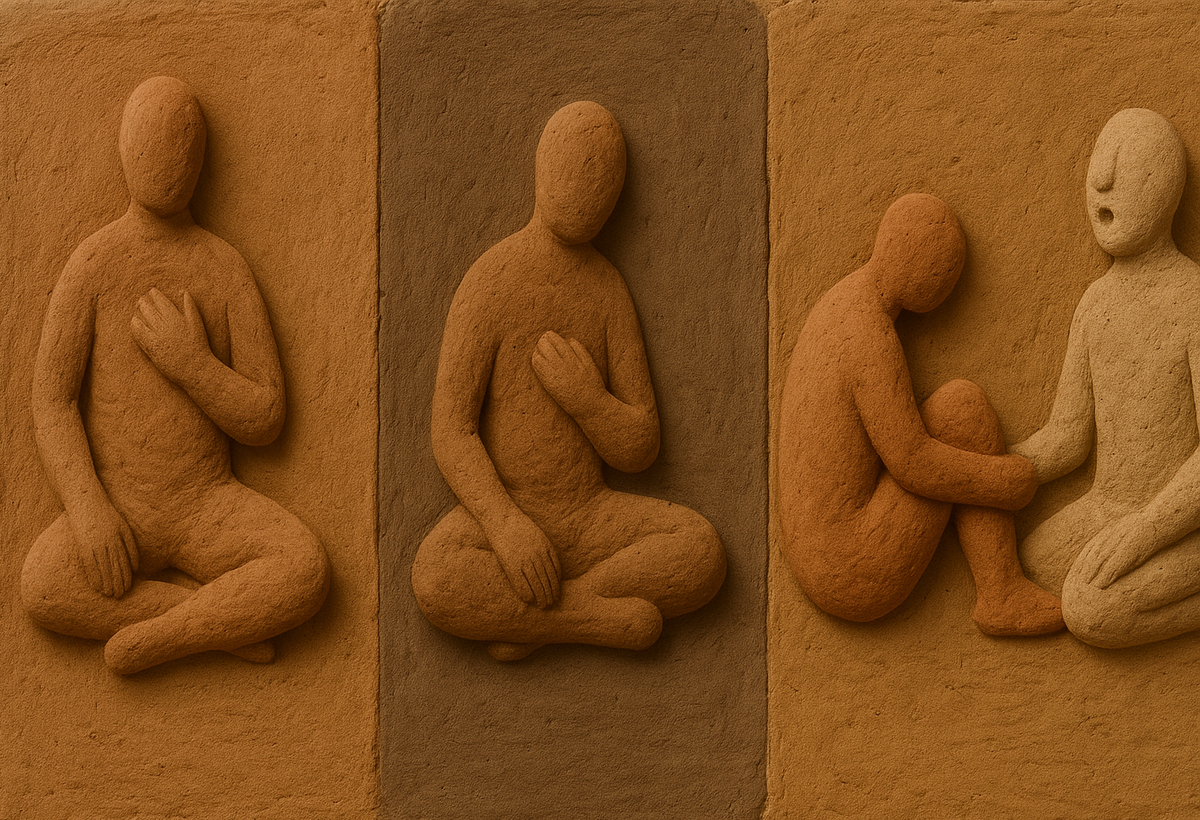5 Somatic Exercises to Ease Stress and Anxiety: Practical Techniques for Calm and Relaxation

Feeling overwhelmed by stress or anxiety can make daily life hard. Many people look for natural ways to improve their mental well-being without needing medication. Somatic exercises are simple body-focused techniques that help calm your mind, ease anxious feelings, and support overall mental health.
These easy movements and practices work by connecting your mind and body to help reduce tension and bring a sense of calm. With somatic exercises, you can use techniques like diaphragmatic breathing, muscle relaxation, and grounding to find quick and effective relief from daily stress and anxiety. Learning to listen to your body can help you restore balance and take back control over how you feel.
Key Takeaways
- Somatic exercises can ease stress and anxiety by focusing on mind-body connection.
- These techniques are easy to do at home and help support mental health.
- Regular practice can lead to better well-being and stress relief.
What Are Somatic Exercises?
Somatic exercises use simple movements and focused attention to help reduce tension and increase your awareness of what is happening in your body. These practices can play an important role in supporting your mental wellbeing.
The Mind-Body Connection
Experiencing stress or anxiety often involves both your mind and your body. Your brain and nervous system constantly send messages that affect how you feel and how your muscles respond.
Somatic exercises build the mind-body connection by encouraging you to pay close attention to physical sensations, such as tightness or heaviness. This increased awareness can help you spot where you carry stress, like tightened shoulders or a clenched jaw.
By noticing these signals, you can learn to respond with purpose instead of staying stuck in reaction. This regular check-in with your body is one reason why somatic practices are helpful for mental health.
How Somatic Practices Work
Somatic practices focus on gentle movement, mindful breathing, and body scanning. They ask you to slow down, move with intention, and notice how each part of your body feels before, during, and after an exercise.
For example, you might try body tapping, progressive muscle relaxation, or grounding exercises. These activities guide your attention away from anxious thoughts and back to your breath or where your feet touch the floor.
This shift helps activate your body’s natural calming system by signaling to your brain that you are safe. Over time, somatic exercises support greater body awareness, making it easier to recognize early signs of stress and respond in a healthier way. You can find some practical examples at NEUROFIT's list of somatic exercises for anxiety.
Benefits for Mental Health
Regular use of somatic exercises may lower your stress levels and support mental wellbeing. When you can spot tension early or calm your body during anxious moments, you often feel more in control of your reactions.
People often report improvements such as better sleep, less muscle pain, and an increased sense of calm. Somatic practices may be especially useful if you have trouble noticing or understanding your emotions, because they give you clear signals from your body to help guide your self-care.
Many find these exercises easy to learn and use in everyday life. They do not require special equipment and can be adapted for different comfort levels, making them a useful addition to any mental health toolbox.
Understanding Stress and Anxiety
Stress and anxiety can affect you physically, mentally, and emotionally. Learning how these experiences impact your body and mind helps you recognize early signs and take helpful actions.
Effects on the Body
When you feel stressed or anxious, your body can react in many ways. The muscles may tense up, your heart might beat faster, and your breathing can become quick and shallow. Some people notice headaches, stomach discomfort, or sweaty palms.
These reactions are part of the "fight or flight" response. Your body releases hormones like adrenaline and cortisol to help you respond to threats. While helpful in danger, these changes can become harmful if they last too long.
Long-term stress or anxiety can weaken your immune system and make you more likely to get sick. You may also have trouble sleeping, feel tired during the day, or notice changes in your appetite. Chronic stress can even lead to ongoing pain or worsen health problems. You can read more about how stress and anxiety affect your body at 10 Easy Somatic Exercises for Stress & Tension Relief.
Role of the Nervous System
Your nervous system controls how you react to stress and anxiety. Two main parts are the sympathetic and parasympathetic nervous systems.
The sympathetic nervous system starts your body's "fight or flight" response. It increases heart rate, raises blood pressure, and sends extra energy to your muscles. The parasympathetic nervous system does the opposite; it helps you relax, calm down, and recover.
When you deal with frequent stress or anxiety, your sympathetic system can become overly active. This can make it harder for your body to return to a relaxed state, even after the stress is gone. Learning somatic exercises may help balance these systems and allow your body to recover from stress and trauma. Read more about how a body-based approach can help regulate the nervous system at somatic exercises for nervous system regulation.
Impact on Well-Being
Stress and anxiety can change the way you think, feel, and act. They can lead to irritability, sadness, or worry, even when nothing is dangerous. You might have trouble focusing, forget things, or feel less motivated.
Constant stress can lower your energy, make you feel disconnected from others, and keep you from enjoying things you used to like. If these feelings last for a long time, they can hurt your mental health and well-being.
Taking steps to manage stress and anxiety is important for your overall well-being. Using somatic techniques can offer relief and improve mental well-being. For practical tips to support your mental health, visit somatic techniques for anxiety relief.
Preparing for Somatic Exercises
To get the most out of somatic exercises, it's important to begin with the right mindset and physical environment. Preparing well can help you feel more safe, relaxed, and ready to pay attention to your body’s signals.
Setting a Safe and Comfortable Space
Start by choosing a quiet space where you will not be disturbed. Make sure the temperature is comfortable and there is enough room to stretch or move if needed.
Use a mat or a soft rug for extra support if you plan to sit or lie down. You may want to have a blanket or pillow nearby for extra comfort and stability. Soft lighting, like lamps or natural daylight, can help reduce stress.
Keep your phone on silent and tell people you need some alone time. If you like, listen to calming music or white noise to block out distractions. Feeling secure in your space can help your body relax, which makes it easier to notice what you’re feeling during the exercises. Creating a safe space also supports you during rehabilitation or times when you feel more sensitive or anxious.
Tuning into Body Awareness
Before you start, take a few slow breaths and let your body settle. Notice where you feel tension, comfort, or discomfort.
Gently scan your body from head to toe using your attention. Try to notice your breathing, heartbeat, and any other physical sensations. You don’t need to change anything at this point; just observe.
Body awareness means paying close attention to what you feel inside your body. This focus helps you recognize stress signals or pain that you might normally ignore. With practice, tuning into your body can support emotional regulation and can be a useful tool during stress or anxiety. This skill is helpful in both daily life and during rehabilitation, as it helps you track changes in how you feel.
1. Diaphragmatic Breathing
Diaphragmatic breathing, also known as belly breathing, is a simple breathwork technique that helps reduce stress by activating the parasympathetic nervous system. Practicing this method can improve both your mental focus and physical relaxation.
How to Practice
To start, sit or lie down in a comfortable position. Place one hand on your chest and the other on your belly, just below your rib cage.
Breathe in slowly through your nose, letting your belly rise as you fill your lungs with air. The hand on your belly should move upward, while the hand on your chest moves very little. Hold your breath for a moment.
Slowly exhale through your mouth, letting your belly fall as you push the air out. Try to make your exhale a little longer than your inhale. Repeat this cycle for a few minutes.
If it helps, count while you breathe. For example, inhale for 4 counts, hold for 1 or 2 counts, and exhale for 6 counts. Practice for five to ten minutes a day. Find step-by-step guidance and tips for diaphragmatic breathing at PositivePsychology.com.
Physical and Mental Benefits
Diaphragmatic breathing helps your body switch from "fight-or-flight" mode to relaxation mode, which means it activates your parasympathetic nervous system. This leads to lower levels of stress hormones, making you feel calmer.
Studies show that deep breathing can improve attention, lower heart rate, and help manage anxiety symptoms. People often report feeling more in control and less overwhelmed after a few minutes of belly breathing.
Physically, you may notice less muscle tension and fewer feelings of restlessness. Mentally, regular practice supports stress relief, better mood, and increased ability to handle daily challenges. You can read more about the mental and physical benefits of diaphragmatic breathing for stress reduction.
Tips for Effective Breathwork
Practice in a quiet place to limit distractions. Try to keep your shoulders and neck relaxed as you breathe.
Wearing loose clothing can help your belly move freely. Set a timer so you do not have to watch the clock.
If you get distracted, gently bring your focus back to the movement of your breath. Some people find that listening to calming music or nature sounds improves the experience.
Make belly breathing part of your daily routine, such as before bed or during stressful moments. Even a few minutes can make a real difference if done consistently. For more suggestions and structure, visit these expert-backed calming breathwork tips.
2. Progressive Muscle Relaxation
Progressive muscle relaxation is a technique that helps you focus on slowly tensing and then relaxing each muscle group. This approach can reduce stress and ease anxiety by making you more aware of physical tension in your body.
Step-by-Step Guide
To begin progressive muscle relaxation, find a quiet place where you can sit or lie down comfortably. Close your eyes and take a few slow, deep breaths.
Start at your feet. Tense the muscles in your toes and feet by curling them tightly for about 5 seconds. Then release and relax for 10 seconds. Move up to your calves, thighs, and so on, working through each area of your body.
Use this list to guide you through each step:
- Toes and feet
- Calves
- Thighs
- Stomach
- Hands
- Arms
- Shoulders
- Neck
- Face
Focus on the difference between how the muscles feel when tense and relaxed. Repeat each step if needed. Practicing a few times each week can help lower stress and anxiety. For more detailed instructions, visit How to do progressive muscle relaxation for anxiety.
Releasing Physical Tension
This method teaches you to notice where you hold physical tension caused by stress or anxiety. When you practice regularly, you may find it easier to let go of tightness in your shoulders, jaw, or back.
Over time, this helps you respond to stress in a healthier way. Persistent physical tension can also lead to headaches or chronic pain. Progressive muscle relaxation is a somatic movement that can offer stress relief and may even aid people with chronic pain to find some comfort.
You do not need special equipment or much time to practice. Even a short session during a stressful day can help you feel more relaxed.
3. Guided Body Scan
Guided body scans can help you relax both your mind and body. This practice uses focused attention to increase body awareness and support stress relief in a simple, accessible way.
Body Scan Techniques
A guided body scan is a type of meditation where you slowly bring your attention to different areas of your body. You usually start at your toes or feet and move upward, noticing how each part feels.
Many guides will ask you to tense and relax each area, which can help release held tension. It's important to notice any sensations—like warmth, tingling, or even discomfort—without trying to change them.
You can follow a recorded body scan, join a class, or do it by yourself. If you prefer a guided session, apps and free videos offer detailed instructions for different lengths of time. For example, this guided body scan and somatic relaxation uses both scanning and gentle humming to support a calm state.
Practicing several times a week, even for just 10 minutes, can make a difference. If your focus drifts, gently bring it back to the part of the body you're observing.
Cultivating Mindfulness
Body scan meditation is also a way to practice mindfulness. During the scan, try to keep your mind on each moment, noticing sensations as they happen.
By observing without judgment, you develop a more mindful relationship with your body. This can help reduce stress because you are training your mind to stay present instead of worrying about things outside the moment.
Mindfulness through body scans often improves your ability to notice how stress affects you physically. Over time, this can help you find new ways to deal with anxiety, and support mental health by breaking cycles of automatic worry.
For more on how body scan meditation can encourage relaxation and awareness, read how to perform a body scan meditation. This method can be adjusted to fit your schedule and comfort, making it a flexible choice for stress relief.
4. Visualization Exercises
Visualization exercises use your imagination to create calming scenes or positive mental images. They can help you manage anxiety, relax your mind, and promote better mental health with regular practice.
Using Guided Imagery
Guided imagery is a type of visualization where you picture peaceful or pleasant settings, following directions from an instructor or audio recording. For example, you might imagine sitting on a quiet beach, hearing the gentle waves, and feeling the warm sun. This process helps shift your focus away from stress or anxious thoughts and onto positive experiences—even if you are just picturing them in your mind.
To start, close your eyes and breathe deeply. Picture yourself in a safe, comfortable place. Focus on the details—colors, sounds, scents, and textures. Notice how your body feels as you imagine this space.
Guided imagery is often used to support stress reduction and ease symptoms of anxiety. If you prefer, you can find recordings or scripts online that will walk you through the exercise step by step. Sessions usually last from a few minutes to about 20 minutes, depending on your needs and the instructions you follow.
Visualization for Stress Reduction
Visualization for stress reduction involves creating mental images that make you feel calm or in control. Unlike guided imagery, where someone else leads you, this technique puts you in charge of what you imagine. You might picture your stress as a color or shape, and then imagine it shrinking, fading away, or floating off into the distance.
List of visualization tips to reduce stress:
- Focus on clear, gentle images (like clouds, water, or light).
- Add as many senses as possible to your visualization.
- Combine visualization with deep breathing for extra relaxation.
Practicing this can help you relax your body and mind, reduce anxiety levels, and support your overall mental health. Over time, you may notice it becomes easier to calm yourself in moments of stress by simply closing your eyes and using these techniques. For extra ideas, you can read more about somatic exercises for anxiety relief.
5. Grounding Techniques
Grounding techniques help you focus your attention on the present moment. These exercises can reduce stress and support your mental well-being by pulling you away from anxiety and unwanted thoughts.
Practicing Grounding for Calmness
Grounding exercises center around engaging your senses—sight, touch, sound, smell, and taste—to direct your mind to the here and now. One effective method is the 5-4-3-2-1 technique. With this simple exercise, you identify five things you can see, four things you can touch, three things you can hear, two things you can smell, and one thing you can taste.
This approach is useful in situations where anxiety or stress begins to rise. Tuning in to your senses lets your mind settle down and makes the world feel more manageable. Basic grounding can also include feeling your feet on the floor or holding a cool object to connect with your body. These small actions can give fast relief in moments of high stress. To learn more about using your senses to ground yourself, see these grounding techniques for anxiety and stress.
Integrating Grounding into Daily Life
You can build grounding into your routine without needing special tools or a lot of extra time. For example, you might pause for a grounding exercise after waking up, during stressful work moments, or before bedtime. Many people find that using grounding as a daily habit helps protect their mental well-being—especially during busy or overwhelming periods.
Try making a list of grounding actions that work for you, like stepping outside barefoot for a moment, splashing your face with water, or focusing on slow breaths. Keeping this list in your phone or journal can be part of your personal support system. By practicing these grounding exercises regularly, you may notice it gets easier to manage worry and maintain your sense of well-being. For more ideas, check out these practical somatic grounding tools.
Incorporating Mind-Body Practices
Physical activities that connect your body and mind can help ease stress, improve your well-being, and support mental health. Using movement, breath, and focus, you can encourage calm and resilience with regular practice.
Yoga for Stress Relief
Yoga combines movement, controlled breathing, and mindfulness. Doing yoga helps stretch tight muscles, steady your breath, and bring attention to the present moment.
Many people practice yoga for its ability to lower stress and help you relax after a long day. Each pose, or asana, gently works the body while encouraging a sense of calm in the mind. Simple routines like Child’s Pose or Cat-Cow are easy to start with and do not require special equipment.
Yoga can boost your mental wellbeing by providing a safe space to notice and release stress. You might also experience better sleep and less muscle tension. Studies suggest that yoga can be as effective as traditional exercise for reducing anxiety and improving mood. Try setting aside 10–20 minutes a day for a basic yoga routine, focusing on slow movements and deep breaths.
Tai Chi and Qigong for Relaxation
Tai chi and qigong use slow, flowing movements and controlled breathing to foster relaxation and reduce anxiety. These ancient practices began in China as forms of exercise and meditation.
You move your body in gentle patterns, matching your breathing and focusing your mind. This helps lower feelings of stress and tension while improving balance and strength. Practicing tai chi or qigong several times a week can help you relax deeply and feel more connected to your body.
Both tai chi and qigong are accessible for most fitness levels, and you do not need any special equipment. Studies show they support well-being and may be helpful for people with anxiety, depression, or chronic stress. If you're interested in learning more about mind-body techniques, check out this list of somatic therapy exercises that support relaxation and improved mood.
Tips for Maximizing Benefits
Getting the most out of somatic exercises means doing them regularly, finding the right help when needed, and taking steps to support your overall wellbeing such as better sleep. Small changes can add up to bigger improvements in stress and anxiety.
Consistency and Routine
Creating a routine for somatic exercises is important. Doing them at the same time every day—for example, right after you wake up or before bed—makes it easier to remember. Daily practice helps your body and mind adjust, lowering stress levels over time.
Keep these tips in mind for best results:
- Set reminders on your phone to practice.
- Try different exercises to find what works best for you.
- Aim for at least 5-10 minutes each session.
A regular schedule helps your nervous system learn how to calm down faster. Over time, these exercises can become a helpful habit for managing anxiety. Read more about daily routines and practical tips at this page on nervous system regulation.
Support and Resources
Having support can help you stick with your exercises and see better results. You may want to join classes or online groups, or find videos with step-by-step guides. Some people benefit from working with a counselor or therapist trained in somatic techniques.
- Look for credible resources that are easy to follow, such as these practical exercises.
- Sharing your experiences with others can build motivation.
- If you’re struggling, a professional’s support can make a difference.
Getting help early can also make your rehabilitation process smoother if you are recovering from physical or emotional issues.
Improving Sleep Quality
Good sleep is key if you want to lower stress and improve wellbeing. Somatic exercises can be helpful before bedtime by calming your mind and relaxing your body. Simple movements like deep breathing, gentle stretching, or body scanning are easy to add to your nightly routine.
Tips for improving sleep quality with somatic exercises:
- Practice slow, controlled breathing for a few minutes before sleep.
- Try a body scan by focusing on relaxing each muscle group.
- Keep your bedroom dark and quiet to support rest.
Better sleep supports your recovery and makes daily challenges easier to handle. This adds to the positive effects of somatic practices, helping you feel more balanced and rested.
Frequently Asked Questions
Somatic exercises use body awareness and movement to help calm your nervous system and ease anxiety. Many can be practiced at home without special tools or training.
What are somatic exercises and how do they alleviate stress?
Somatic exercises focus on tuning into your body’s sensations. This awareness helps you notice tension and release it. Movement, deep breathing, and gentle tapping can switch your body from “fight or flight” to a more relaxed state.
Can somatic exercises help with anxiety management?
Yes, somatic exercises can help manage anxiety. Techniques like grounding, controlled breathing, and shaking out tension help calm both your mind and body. These exercises help reduce anxious thoughts by connecting you to the present moment.
What are the top somatic techniques for stress reduction?
Some of the most helpful techniques include body tapping, belly ball rolling, grounding, and mindful movement. Even simple actions like shaking your hands or tapping your feet can release built-up stress. For more examples, you can review this list of somatic exercises for anxiety.
How often should somatic exercises be practiced for anxiety relief?
You can practice somatic exercises daily. Many people find that short, regular sessions work best. Even five to ten minutes a day can make a difference in how you handle stress and anxiety.
Are there specific somatic exercises that target stress in the brain?
Breathing techniques, such as the “physiological sigh,” and grounding exercises help lower stress in the brain by calming the nervous system. Gentle body movements also send signals to your brain that you are safe and can relax. Learn about more techniques at this guide on somatic techniques for anxiety relief.
What are some free somatic exercises to try for stress and anxiety?
You can try exercises like body scanning, progressive muscle relaxation, and deep diaphragmatic breathing. Grounding techniques such as focusing on your senses are also free and easy to do. Find more options in this list of free somatic exercises for stress.




